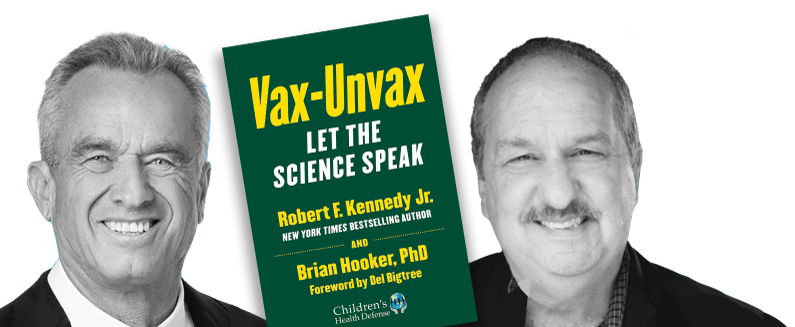Use of Drugs to Restrain Kids in Mental Health Facilities Jumps 141%
Critics called for an outright ban on chemical restraints in mental health facilities after a study showed a steep rise in the number of children being subjected to them. They cited the lack of informed consent and a culture of medicalization that leads to labeling, misdiagnosis and over-prescribing of drugs that can cause suicidal and homicidal ideation.
Miss a day, miss a lot. Subscribe to The Defender's Top News of the Day. It's free.
More children are being subjected to drug restraints because more children are being admitted to mental health facilities, a new American Academy of Pediatrics (AAP) study found. Pharmacological restraints tend to be used with greater frequency on autistic children, low-income children and children of color.
Although the average rate for the use of drug restraints among all children ages 5-17 years old with any diagnosis remained relatively steady during the 2016-2021 study period, the analysis found a 141% increase in the use of restraint drugs overall, alongside lengthening inpatient stays.
This means more children are being hospitalized for mental health conditions and more are being subjected to drug restraints — antipsychotics used to sedate — and in ways that disproportionately disadvantage some youth.

In November, the Citizens Commission on Human Rights International (CCHR) called for a ban on all psychiatric and physical restraints, citing a similar World Health Organization (WHO) statement and an October Los Angeles Times exposé on the coercive use of restraints in psychiatric facilities.
Experts who spoke with The Defender argued reliance on chemical restraints reflects the failure of a treatment model dominated by biological psychiatry rather than offering real or lasting solutions.
Given the lack of safety data on psychotropic drugs, especially for children (for antipsychotics, attention deficit/hyperactivity disorder (ADHD) medications, and antidepressants), and the alleged lack of scientific basis for mental health diagnoses, experts emphasized the need for informed consent and refusal rights as a means to combat the reflexive overmedication of distressed children.
Study demonstrates need for path to ‘zero restraints’
The analysis published in Pediatrics examined more than 90,000 mental health hospitalizations across 43 children’s hospitals. It defined pharmacological restraint narrowly as intravenous or intramuscular administration of five heavy-duty antipsychotics.
Despite the average restraint rate holding constant at around 3% over the five years of the study, there were significant increases over time — ranging from 40% to 323% — in the drug restraint rates for children diagnosed with disruptive disorders, bipolar disorders, eating disorders and somatic symptom disorders, compared with a decline in the use of drug restraints for other diagnoses.

The analysis revealed racial minorities and economically disadvantaged children disproportionately undergo chemical restraints. Younger Black males faced double the likelihood of restraint compared to their white peers, as did children insured by federal programs, such as Medicaid, versus those with private insurance.
Patients from households earning under $25,000 per year likewise encountered heightened odds of restraint.
Although drug restraint use for children with autism spectrum disorder (ASD) decreased by 20% over the study period, it still topped all other conditions. When used, the drug restraints were applied for an average of nearly 8% of inpatient days.
The study authors noted a 138% rise in mental health patient days from 2016 to 2021, which they said may have contributed to the worsening shortage of inpatient and outpatient pediatric psychiatric resources, leading to an increase in the use of restraints.
The researchers attributed the patient load to “an increased severity and frequency of mental health conditions in the setting of the coronavirus disease 2019 pandemic,” noting, in particular, the incidence of “acute agitation,” but did not further analyze the underlying drivers.
The authors of a response posted alongside the study agreed with the study’s authors on the need to create a standardized national definition of pharmacologic restraint use in pediatrics and to tailor more individualized treatment strategies, including non-drug methods. However, they also called for envisioning a path to “zero restraints.”
Restraint drugs and their dangers
The Pediatrics study centered on the use of five antipsychotic drugs: aripiprazole, droperidol, haloperidol (Haldol), olanzapine and ziprasidone. These act as powerful nervous system depressants that rapidly sedate children.
All carry U.S. Food and Drug Administration (FDA) “black box” warnings for side effects that include the possible impairment of normal mental or physical functioning or increased mortality risks.
According to the FDA, aripiprazole may provoke suicidal thinking and behavior in children, and may also cause seizures, cognitive and motor impairment and other side effects.
Droperidol can cause agitation, anxiety, seizures, confusion and insomnia, among other disorders.
Ziprasidone also may cause seizures, cognitive and motor impairment, and neuroleptic malignant syndrome, fatal skin reactions and suicide.
Both droperidol and ziprasidone pose dangers related to irregular heart rhythms, which can prove fatal.
The FDA label for haloperidol states, “Safety and effectiveness in pediatric patients have not been established.” The label lists such adverse reactions as cardiovascular effects, neuroleptic malignant syndrome, leukopenia, neutropenia, agranulocytosis and other conditions.
Olanzapine carries similar warnings as the other antipsychotics, plus headache, increased appetite, weight gain, abdominal pain, fatigue, suicide and other adverse reactions.
Haloperidol, olanzapine and ziprasidone additionally carry warnings about an increased risk of death in elderly patients.
The study authors acknowledge the dangers of these drugs, saying “all forms of restraint should be used judiciously because they can be associated with significant medical and psychiatric complications.”
The response article advocating zero restraints argued this narrow framing of just the five drugs likely underestimated total restraint use by omitting other concerning agents like benzodiazepines and chlorpromazine, and its analog prochlorperazine, which can also be used for restraint.
The World Psychiatric Association in 2020 warned that restraints and other coercive treatments carry the risk of “harmful consequences, including trauma” and “individuals subject to physical coercion are susceptible to harms that include physical pain, injury, and death.”
But tracking restraint use in the U.S. is difficult, according to CCHR, because of the variability in reporting and coding practices between hospitals nationally.
Psychiatric drugging of kids ‘causes more harm than good’
Sheila Matthews, co-founder of AbleChild, a national nonprofit that focuses on informed consent and the right to refuse psychiatric products and services, told The Defender these drugs often get administered without proper informed consent procedures, including an explanation of the range of possible harms to children or caregivers.
Matthews criticized the Pediatrics study for not defining how many children come into the hospital already on psychiatric drugs that may be causing side effects like aggression or self-harm before they’re given more drugs to restrain them.
The result is these hospitals end up using “a cocktail of all different sorts of drugs” on the children, she said.
Andrew Thibault, director of “Speed Demons” and an activist who sued the FDA to obtain adverse event reports for children taking psychotropic medications, agreed with Matthews’ assessment.
“The study misses the forest for the trees in ignoring the root cause of such hospitalizations,” he told The Defender. “Many children requiring mental health hospitalization were in fact prescribed Schedule II psychostimulant medications for ADHD, which are labeled for … wait for it … aggression and agitation.”
Amy Miller, director of marketing for Reform Pharma, a Children’s Health Defense (CHD) initiative, echoed Thibault’s concern. Miller said many of these drugs come with “FDA black box warnings such as aggression, addiction, suicidal and homicidal thoughts — the same issues they are trying to treat,” she told The Defender.
“So many children are labeled at such a young age and prescribed psychotropic drugs that carry the risk of addiction,” Miller said, adding, “The system is setting them up for failure.”
“Our children are dying under their care,” Matthews said. “You only have to pull up any fatality review report from any state, and you can see the suicide statistics.” Meanwhile, she said, “They don’t tell you how many have committed suicide while on a drug with a black box suicide warning.”
Neither the child nor the parent are made aware of the dangers, “and that’s a human rights violation,” she said.
Thibault pointed to a study of psychiatric institutions in Australia and New Zealand that found 9 of 10 homicides were committed by patients on psychiatric medications.
“This latest study points to the unavoidable conclusion that psychiatric drugging of children causes more harm than good,” he said.
AbleChild on Dec. 12 issued a statement questioning whether the Maine mass murderer Robert Card was misdiagnosed by the “vast, vast, vast psychiatric industry” when, after being “placed on a cocktail of drugs that did nothing to address the brain injury,” he was allowed to go free.
Meanwhile, according to Matthews, state behavioral health agencies and healthcare industry lobbyists use suicide statistics and mass homicide events to “beg legislatures for more money to expand mental health services,” all while “fraudulently” hiding statistics that would implicate the drugs that can cause suicide and homicide.
These are the same drugs likely to be increasingly prescribed under the mental health expansion efforts, she said.
Matthews shared the example of a Killingly Connecticut Board of Education meeting earlier this month to address student mental health services. Board members reviewed a survey of students that found roughly 15% had suicide plans. The survey failed to ask if the children were already being treated with black box suicide drugs, Matthews said.
‘We are … medicating boyhood in this country’
The Pediatrics study found disproportionately higher rates of pharmacologic restraint use for children ages 5-8, males, non-Hispanic Black children, children on the autism spectrum (also a higher proportion of males), children with families on public insurance, children from households with the lowest median incomes, children with the lowest Child Opportunity Index scores and patients staying in a facility longer than seven days.
Children on the autism spectrum run a much higher risk of enduring long-term restraints in mental health settings — 8% of patient days versus 1.3% on average for all other conditions, although over the study period, overall rates declined.
A 2012 study by the National Institute of Mental Health (NIMH) found 56% of children diagnosed with ASD were taking one or more medications. Abilify (aripiprazole) and Risperdal, another antipsychotic, are the only drugs approved for the treatment of ASD-diagnosed children.
Thibault said, “It’s no surprise that the study found young males more likely to be chemically restrained in a hospital setting, as boys are 6 times more likely to be diagnosed with and medicated for ADHD than girls.”
“We are, in effect, medicating boyhood in this country,” Thibault said.
Notably, prescriptions for ADHD drugs for children and young adults ages 2-22 nearly doubled between 2006 and 2015.
This month an Ohio teacher revealed the increasing medicalization of children in school, alleging in one instance the school psychologist and others were “trying to intimidate and scare” a parent into giving their child ADHD medication even after the parent had observed unwelcome personality changes when the child previously took such medications.
According to the CCHR report, “An astounding number of schools” in the U.S. are resorting to the use of restraint and seclusion rooms, a practice it blames on the “psychiatric culture today that drugs children’s behavior to be compliant and can drive them to suicide or acts of violence.”
Miller said Reform Pharma is greatly concerned about prescriptions for “mood disorders” aimed at children and adolescents. Between 2015 and 2019, prescriptions for antidepressants for teenagers rose by 38% — and that number has only increased since the pandemic began.
“Money is being poured into mental health to ‘increase access’ to services,” Miller said. “That means there will be more labeling of children and more prescribed psychotropic drugs that carry FDA black box warnings such as suicidal and homicidal ideation and addiction.”
Justine Tanguay, CHD lawyer and Reform Pharma’s director of campaign research, told The Defender she’s concerned about the link between expanding child mental health screenings and the development of AAP-supported school-based health centers (SBHCs).
According to Tanguay, SBHCs will be run by the local health departments and will have direct access to a minor child and the ability to encourage that child to make personal healthcare decisions without the need to consult with and seek approval from a parent.
“The opportunity to circumvent both parental rights and informed consent is ripe for abuse since SBHCs … have no regulatory oversight,” she said.
Meanwhile, state foster care systems for many years have been complicit in the drugging of children for the purposes of restraint, Matthews told The Defender.
Federal audits in Indiana, Michigan and Ohio found inadequate oversight of psychotropic drug use among foster kids. In Maryland, up to 34% of foster children are given psychotropic drugs without proper diagnoses, with over half of those receiving more than one drug.
AbleChild has been fighting against this practice since at least 2004, Matthews said, when it reported Black youth died in state custody and required mental health interventions at alarming rates. A psychiatrist in a Texas hearing that year said, “These children are from a bad gene pool,” she said.
CCHR, in a report issued in February, said at least 1 in 4 children in foster care between the ages of 16 and 17 is administered at least one psychotropic drug.
Medicaid spending on antipsychotic drugs, which was $166 million in 1991, reached $3.3 billion in 2015 for a list of just five antipsychotics, according to CCHR, including three listed in the Pediatrics study: aripiprazole (Abilify), olanzapine (Zyprexa) and ziprasidone (Geodon).
“The fact that children with public insurance were more likely to be subjected to pharmacologic restraint begs the question of whether there exist financial incentives to drug children and hold them hostage as long as the government is picking up the tab,” Thibault said.
Psychiatrists ‘overreached, overpromised, overdiagnosed, overmedicated’
The Pediatrics study did not explore the uncertainties around the diagnostic categories used to classify patient mental health issues, only admitting a knowledge gap concerning “factors that are associated with increased agitation.”
According to Harvard professor and historian Anne Harrington in her book “Mind Fixers: Psychiatry’s Troubled Search for the Biology of Mental Illness,” the biological basis of almost all mental disorders remains as unknown today as it was in Freud’s time.
But according to Harrington, in the 1980s, following rapid developments in neuroscience, genetics and psychopharmacology, scientists believed they had come upon “irrefutable evidence that mental disorders were brain diseases,” and thus focused on the brain as the “primary object of psychiatric research, diagnosis, and treatment.”
However, they ultimately “overreached, overpromised, overdiagnosed, overmedicated and compromised its principles,” she wrote.
Harrington chronicled the repeated embrace by practitioners of brain-based theories of mental illness lacking proof. “They believed biological … markers and causes would eventually be discovered for all the true mental disorders,” she wrote of psychiatry’s Diagnostic and Statistical Manual (DSM), despite such discoveries never materializing, according to The Atlantic.
Harrington even challenged the “chemical imbalance” theory of mental illness, according to Wikipedia:
“[Harrington] writes, ‘Ironically, just as the public was embracing the ‘serotonin imbalance’ theory of depression, researchers were forming a new consensus about the idea behind that theory: It was ‘deeply flawed and probably outright wrong.’”
Concerned over the lack of proof in psychiatric diagnoses, NIMH in 2013 said it would be shifting its funding away from DSM categories.
Commenting on the call for developing “best practices” in the use of child restraints by the authors of “zero restrains” article, Matthews said the psychiatric industry has never been held accountable by Congress on what it defines as best practices.
“They can’t standardize it because there’s no way to determine whether a child has one of these mental disorders,” she said. “There’s no science behind psychiatry. What does ‘best practices’ mean when these drugs severely hurt and even kill kids?”
Without a provable biological basis for mental health conditions or transparency around drug side effects, psychiatrists are engaging in “ongoing violations of informed consent,” according to Matthews.
“There’s no informed consent because right now they have the legal right under our system to commit you and forcibly restrain you” under the guise of helping you, Matthews said.
Tanguay told the Defender that by law, a healthcare provider is required to educate a patient as to the risks, benefits and alternatives to a given medication or medical procedure.
Since minor children lack adequate knowledge, they typically cannot provide informed consent. “Therefore, it’s the parents who have the authority to give fully informed consent or refusal and without it, it can constitute malpractice,” she said.
“Our children’s identity was stolen by the mental health industry,” Matthews said. “We [at AbleChild] believe in the National Defense Education Act, and all this drugging of children is actually in violation of that.”
Calls for reform
The November CCHR report called for legislative protections to prohibit “chemical and physical restraint and punitive seclusion rooms, not only in the U.S. but globally.”
The WHO in its June 2022 draft guidelines document, “Guidance on Mental Health, Human Rights, and Legislation,” stated, “There is a growing consensus that all forms of restraint and seclusion in mental health services should be eliminated” and that such practices are “contrary to international human rights law” and “incompatible with a recovery approach.”
According to the WHO:
“The U.N. Special Rapporteur stressed that purportedly ‘benevolent’ purposes, such as ‘medical necessity,’ ‘re-education,’ … do not vindicate coercive or discriminatory practices and may amount to torture. There is an immediate international obligation to end these practices. All persons should be able to exercise their right to give free and informed consent to accept or reject treatment in mental health systems.”
In an October statement, the WHO called for ending coercive practices, improving community-based mental health care options and adopting a rights-based approach to mental health.
Dr. Peter Breggin, an expert on psychotropic drugs, recommended that parents avoid putting their children on psychiatric medications. He hopes society will view diagnosing and drugging children as a “huge and tragic mistake,” focusing instead on approaches that truly support children’s needs. He sees prohibiting psychiatric drugging of children as a legitimate goal, like banning other forms of abuse.
Matthews said the current situation of forcibly drugging children will not change “until taxpayers get the attention of the lawmakers.”
To that end, AbleChild created a petition calling for federal hearings into the expansion of child mental health services in light of the increased use of drugs that carry black box warnings about suicide and homicide.
Miller said federal and state governments along with nonprofits like the AAP “who do the work of Big Pharma” must be held accountable for funding and pushing the use of psychotropic drugs without proper data.
Reform Pharma, launched in November, is pursuing a comprehensive plan to end Big Pharma corruption and restore healthcare integrity, which includes the reform of regulatory and oversight agencies, the restoration of scientific integrity and research in publications, the end of direct-to-consumer drug advertising, and the closing of the revolving door between government and industry.
Part of that plan includes “untangling mental health funding” to show how the money is pouring into communities, and ending “the corrupt cycle of sickness and pharmaceutical dependency,” Miller said.
Sign up for free news and updates from Children’s Health Defense. CHD focuses on legal strategies to defend the health of our children and obtain justice for those injured. We can't do it without your support






